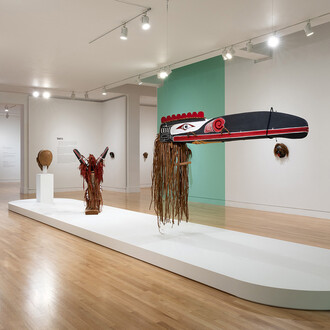The exhibit Inspiring Rockets explores the influence model rocketry has had in shaping the lives of young enthusiasts since the beginning of the space age. Developed in partnership with the National Association of Rocketry, the exhibit showcases artifacts from the Museum of Flight's G. Harry Stine, and Vern and Gleda Estes collections of model rockets. It also includes several recent examples of championship-winning hobby and sport rockets built and flown by rocketeers young and old.
Model rocketry developed during the late 1950s as a way to channel the energy and improve the safety culture of a growing population of young rocketeers inspired by the arrival of the Space Age. These enthusiasts had been scratch-building metal rockets and mixing their own highly explosive propellant, which resulted in many unfortunate accidents.
Writer and rocket engineer G. Harry Stine, wrote an article for Mechanix Illustrated entitled “The World's Safest Business,” describing safety practices for anyone attempting to build and launch a rocket. Orville Carlisle, a shoe salesman and pyrotechnic hobbyist in Nebraska, read the article. He wrote to Stine to tell him about a model rocket kit and engine he had developed in 1954 and hoped to produce and sell.
Stine felt that Carlisle’s single-use, prefabricated engines would solve the biggest problem in amateur rocketry—homemade propellant. He partnered with Carlisle to form the company Model Missiles, Inc. (MMI) in 1957. The company would produce rocket kits and safe, single-use engines from Carlisle’s designs.
The demand for model rockets soon grew beyond MMI’s ability to meet demand. A young man named Vernon Estes, whose father was in the fireworks business, offered to develop a machine that would produce rocket motors faster than MMI was able to do.
Estes built motors for MMI until the company closed in 1966. In 1959 he formed his own company, Estes Industries, today known worldwide for its model rocket products.
G. Harry Stine and Orville Carlisle established the National Association of Rocketry (NAR) in 1957 to support the growing hobby of model rocketry. The NAR provided a framework for the formation of rocketry clubs across the United States. The organization helped establish safety standards for the hobby and supported—and continues to support—a wide range of rocketry activities from coordinating the launches of small, introductory kits to high-power custom-built rockets flown by experienced adult hobbyists.
Today, the NAR is the oldest and largest spacemodeling organization in the world. The group boasts over 5800 members and 150 affiliated rocket clubs across the United States.
















